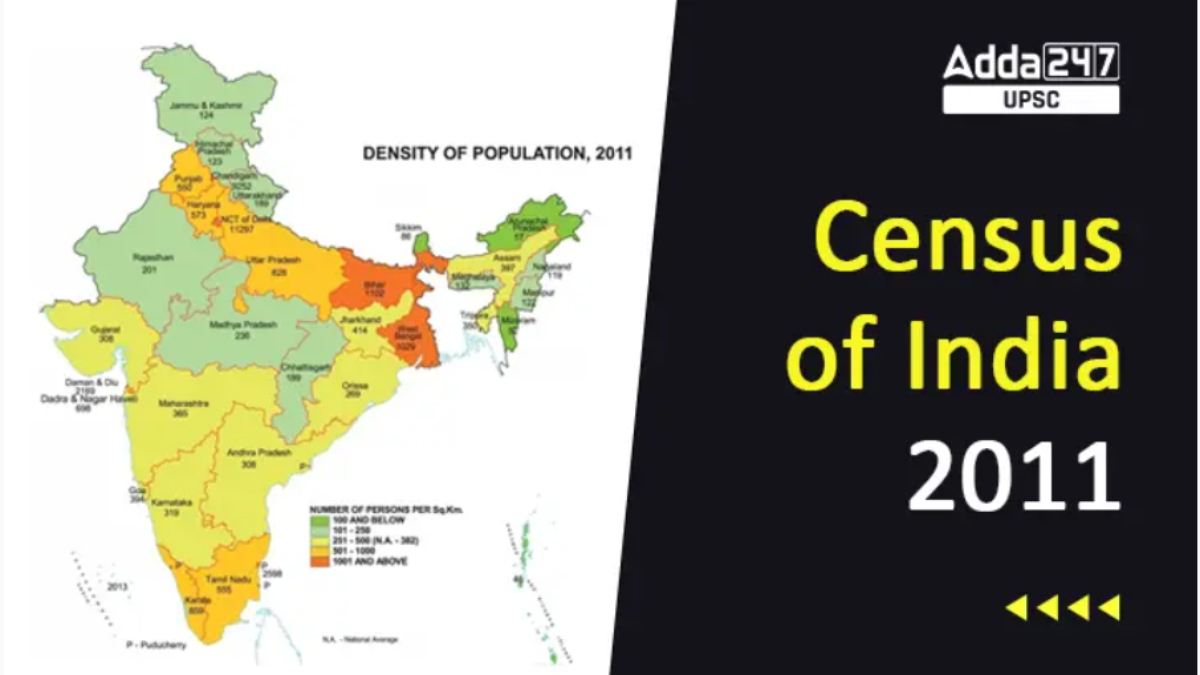Table of Contents
The 15th Indian Census, conducted in 2011, comprised two main phases: house listing and population enumeration. Commencing on April 1, 2010, the house listing phase involved collecting data on all structures, including details for the National Population Register (NPR). The NPR initiative aimed to allocate a unique 12-digit identification number to registered Indian residents via the Unique Identification Authority of India.
The Census of India 2011 was the 15th national census, carried out in two main phases:
⇒ House Listing: Started on April 1, 2010, this phase involved collecting information about all buildings.
⇒ Population Enumeration: This began on February 9, 2011, and ended on February 28, 2011.
Key findings from the 2011 Census of India:
- Total Population: 1,210,854,977, an increase of 181.5 million from the 2001 census of India
- Most Populous States based on Census of India 2011:
State Population Uttar Pradesh 199,812,341 Maharashtra 112,374,333 Bihar 104,099,210 West Bengal 91,347,736 Andhra Pradesh 84,665,297 Madhya Pradesh 72,626,199 - Sex Ratio: 940 females per 1,000 males
- Child Sex Ratio (0-6 years): 914 females per 1,000 males
- Literacy Rate: 74.04% overall
⇒ Males: 82.14%
⇒ Females: 65.46%
Read More: UPSC Indian Polity Notes
Interesting Facts about Census of India 2011
Here are some key facts from the 2011 Census:
- The average household size in India is 5.5 people.
- Hindi is the most spoken language, followed by Bengali, Marathi, Telugu, Tamil, and Urdu.
- The majority of Indians (80.5%) identify as Hindu, with Muslims at 13.4%, Christians at 2.3%, Sikhs at 1.9%, and Jains at 0.4%.
- The urban population stands at 377 million, making up 31.2% of the total population.
- The median age of people in India is 27.2 years.
Download PDF Census of India 2011
Importance Of Census of India 2011
The 2011 Census of India is important for many reasons. It provides a detailed picture of India’s population, covering areas like demographics, economic activity, literacy, housing, and household facilities. Government agencies use this data to plan for the future and make improvements in people’s lives. Here are some specific reasons why the 2011 Census is valuable:
- It gives a clear overview of India’s population and its needs.
- It helps in planning for education, healthcare, and housing.
- It highlights areas that may need more support or resources.
| Census of India Purpose | Description |
| Planning and Policy Making |
→Helps government agencies plan for future needs and develop policies
→Population growth data for planning schools, hospitals, and infrastructure
→Literacy data for educational programs →Household amenities data for improving access to essential services
|
| Resource Allocation |
→Allocates resources to different regions of India
→Poverty data targets government programs in needy areas →Urbanization data for developing new cities and towns →Population growth data allocates resources to rapidly growing areas |
| Monitoring Progress |
→Monitors progress on key development goals
→ Literacy data tracks progress towards universal literacy →Child mortality data monitors progress in reducing child mortality →Gender equality data tracks progress towards gender equality |
| Research and Analysis |
→Used by researchers and analysts to study population growth, urbanization, poverty, and gender equality
→ Informs policy-makers and helps develop programs to meet population needs |
| Valuable Resource |
→Provides detailed information on India’s population
→Helps understand trends in population growth, urbanization, and literacy →Identifies disparities in access to education, healthcare, and essential services |
Census of India 2011- Data
The 15th national census of India, conducted in 2011, took place in two distinct phases: house listing and population enumeration. Commencing on April 1, 2010, the house listing phase involved the comprehensive collection of information pertaining to all structures. Subsequently, the population enumeration phase for census of India was executed from February 9, 2011, to February 28, 2011.
According to the 2011 census of India findings, India’s population stood at 1,210,854,977, marking a surge of 181.5 million individuals compared to the figures recorded in the 2001 census. Uttar Pradesh emerged as the most populous state, harboring 199,812,341 inhabitants, followed by Maharashtra with 112,374,333, Bihar with 104,099,210, West Bengal with 91,347,736, Andhra Pradesh with 84,665,297, and Madhya Pradesh with 72,626,199 residents. Below are some notable data highlights from the Census of India 2011:
- Population: 1,210,854,977
- Sex ratio: 940 females per 1,000 males
- Child sex ratio: 914 females per 1,000 males
- Literacy rate: 74.04%
- Urban population: 377 million (31.2%)
- Median age: 27.2 years
- Most spoken language: Hindi
- Major religions: Hinduism, Islam, Christianity, Sikhism, Jainism
For those seeking deeper insights into India’s population dynamics, the information gathered during the Census of India 2011 stands as a valuable asset. This data from Census of India 2011 holds the potential to illuminate patterns in population expansion, urbanization trends, and literacy rates. Moreover, it serves as a valuable tool in pinpointing regions characterized by inequalities in terms of education, healthcare access, and critical services.
Accessible through the official platform of the Office of the Registrar General and Census Commissioner, India, the Census of India 2011 data is readily available online. Alongside the data itself, the website offers a range of tools and resources designed to facilitate the exploration and analysis of this comprehensive dataset.



 TSPSC Group 1 Question Paper 2024, Downl...
TSPSC Group 1 Question Paper 2024, Downl...
 TSPSC Group 1 Answer key 2024 Out, Downl...
TSPSC Group 1 Answer key 2024 Out, Downl...
 UPSC Prelims 2024 Question Paper, Downlo...
UPSC Prelims 2024 Question Paper, Downlo...





